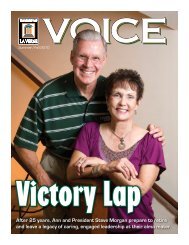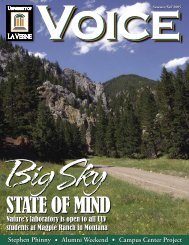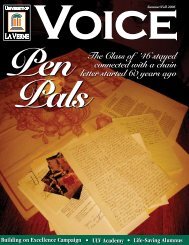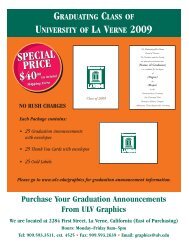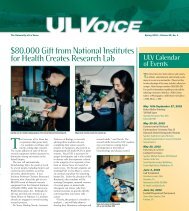The Ceremony - University of La Verne
The Ceremony - University of La Verne
The Ceremony - University of La Verne
You also want an ePaper? Increase the reach of your titles
YUMPU automatically turns print PDFs into web optimized ePapers that Google loves.
COLLEGE OF EDUCATION & ORGANIzATIONAL LEADERSHIP<br />
Continued from 14<br />
Delgado’s other big challenge is the Head<br />
Start program.<br />
“L.A. County has the largest Head Start<br />
program in the nation. We are expanding<br />
programs and trying to get kids ready<br />
for school, especially in poor areas. <strong>The</strong>re<br />
is a great opportunity for doing some good<br />
things. Already, I’m excited,” he said.<br />
Delgado said one <strong>of</strong> his top goals is to take<br />
a look within the organization and streamline<br />
it. That will allow the county to be better<br />
positioned to respond to needs, he said.<br />
He will undoubtedly tap into the foundation<br />
he received at <strong>La</strong> <strong>Verne</strong> to do that.<br />
His education at <strong>La</strong> <strong>Verne</strong> helped him discover<br />
his own leadership style, he said.<br />
“You learn to build bridges and listen and<br />
hear perspectives about education and organization<br />
and leadership. Working together<br />
with people with different styles was a big<br />
help,” Delgado said. “You discover your own<br />
style through that process.”<br />
Thomas agreed. He also earned his master’s<br />
degree at <strong>La</strong> <strong>Verne</strong>.<br />
“I was really looking for a program that<br />
recognized that people who were working<br />
full-time would need flexibility,” he said. “<strong>La</strong><br />
<strong>Verne</strong> just had a very accommodating model<br />
which allowed me to do my job as well as get<br />
my course work done. That degree and administrative<br />
credential helped me secure my<br />
first administrative position.”<br />
<strong>The</strong> degrees at <strong>La</strong> <strong>Verne</strong> prepared Thomas for<br />
managing schools and districts and becoming a<br />
strong leader. “In addition, I would say in the<br />
doctoral program, we did a lot with emerging<br />
technologies, which was extremely helpful.”<br />
Thomas began his career in 1979 as a junior<br />
high social studies teacher in the Charter<br />
Oak Unified School District. That wasn’t<br />
exactly what he had planned. He had aspired<br />
to teach high school but was told he was too<br />
young; he was only 22.<br />
“I ended up in junior high. I swore I<br />
would never teach junior high and I spent<br />
my entire teaching career there,” he said. “I<br />
just remember how I was when I was a junior<br />
high kid and I didn’t want to deal with that.”<br />
He spent some time thinking about the<br />
middle school teachers he’d had and tried to<br />
emulate what they did in the classroom. That<br />
proved to be successful, he said. He realized he<br />
needed to have respect for the age group, set<br />
guidelines and rules for students and then fol-<br />
16 VOICE Summer/Fall 2011<br />
low through with enforcing the rules. He also<br />
knew to make the classroom environment fun.<br />
When Thomas first began teaching, educators<br />
and students were not facing the same pressures<br />
they are today. “We have a larger array <strong>of</strong><br />
indicators people watch to determine whether<br />
there is success,” he said. “<strong>The</strong> formulas and<br />
things people have used have changed.”<br />
Thomas said he has seen a deterioration <strong>of</strong><br />
support for public education. Class sizes are<br />
larger than they have ever been, schools have<br />
skeleton support staff and it has been difficult<br />
for schools to obtain the material and<br />
equipment they need.<br />
Despite all <strong>of</strong> that, “We have still seen<br />
an increase in student achievements,” said<br />
Thomas, whose county serves about 417,000<br />
students in 538 schools. “Teachers in the<br />
“I ended up in junior high. I<br />
swore I would never teach<br />
junior high and I spent<br />
my entire teaching career<br />
there. I just remember how<br />
I was when I was a junior<br />
high kid and I didn’t want<br />
to deal with that.”<br />
— Gary Thomas<br />
San Bernardino County<br />
Superintendent <strong>of</strong> Schools<br />
classrooms as well as principals are doing an<br />
extraordinary job given the reduction <strong>of</strong> resources<br />
that we have had.”<br />
Thomas, who has held numerous administrative<br />
positions and who served as superintendent<br />
<strong>of</strong> the Silver Valley Unified School<br />
District and the Lucerne Valley Unified<br />
School District, began his first full four-year<br />
term in January; he had spent the previous<br />
two years filling out the term <strong>of</strong> the former<br />
superintendent. His priorities include closing<br />
the access and achievement gap, improving<br />
dropout and graduation rates and preparing<br />
students for college and careers. He<br />
is particularly passionate about a program<br />
designed to increase college-readiness.<br />
<strong>The</strong> Early Assessment Program (EAP)<br />
is a collaborative effort between the California<br />
Department <strong>of</strong> Education (CDE),<br />
the California State <strong>University</strong> (CSU),<br />
and the State Board <strong>of</strong> Education (SBE)<br />
to avoid incoming CSU students’ need for<br />
remediation in English and mathematics.<br />
Students take a voluntary test in the 11th<br />
grade; the results give them an idea <strong>of</strong> their<br />
college readiness in English and math. Students<br />
with acceptable scores on the EAP who<br />
are admitted into the CSU system can enroll<br />
in college credit-bearing courses in those<br />
subjects as entering freshman without taking<br />
remedial courses. If a student does not pass<br />
the EAP, that student can be <strong>of</strong>fered solutions<br />
in his or her senior year.<br />
“What we are really trying to do is move the<br />
remediation to the K-12 side,” Thomas said.<br />
<strong>The</strong> San Bernardino County Superintendent’s<br />
<strong>of</strong>fice, working with Cal State San<br />
Bernardino and the Chaffey Joint Union<br />
High School District, has developed a pilot<br />
where Cal State San Bernardino will<br />
provide a guarantee <strong>of</strong> admission for all<br />
graduating Chaffey seniors who successfully<br />
complete CSU entry requirements<br />
and achieve passing rates on the EAP.<br />
Three community colleges — Chaffey, Crafton<br />
Hills and Victor Valley — also have<br />
agreed to accept EAP scores and UC Riverside<br />
has agreed to look at the program,<br />
Thomas said.<br />
“We are really pushing to get as many<br />
partners as we can in the pilot,” he said.<br />
“<strong>The</strong> effort here is to see that EAP students<br />
are coming into college successfully prepared<br />
for college-level coursework, to align high<br />
school coursework and college-entrance requirements,<br />
and to reduce higher education<br />
remediation costs.”<br />
For Delgado and Thomas, the most rewarding<br />
part <strong>of</strong> their jobs is seeing the impact<br />
– in the short-term and over the longterm<br />
– <strong>of</strong> education.<br />
“You are really transforming lives — anything<br />
from that first-grader who all <strong>of</strong> sudden<br />
discovers he can read, to a high school student<br />
who finally works out algebra or geometry, to<br />
the first time a kid has an opportunity to perform<br />
on a live stage,” Thomas said.<br />
“<strong>The</strong> artistry that comes out <strong>of</strong> youth is<br />
amazing. I think opening minds <strong>of</strong> people<br />
about the possibilities that there are, that is<br />
really exciting about education.”<br />
Related story: Read about the College <strong>of</strong><br />
Education & Organizational<br />
Leadership’s recent accreditation at:<br />
http://laverne.edu/voice/2011/11/ceol<br />
A Work<br />
In Progress<br />
After earning four academic degrees and a<br />
42-year career as librarian, Marlin Heckman<br />
is most excited about what’s yet to come.<br />
By Mark Vidal<br />
If there is one thing Marlin Heckman lacked when he retired after<br />
31 years as head librarian, it was the mentality <strong>of</strong> slowing down.<br />
He didn’t have it then, and he doesn’t have it now. Between prepping<br />
for his upcoming books, attending book signings, traveling the<br />
world and working on his iPad, Marlin has lived up to the mission he<br />
shares with the <strong>University</strong> <strong>of</strong> <strong>La</strong> <strong>Verne</strong>: lifelong learning.<br />
“I read about a book a week, usually have two or three going sometimes.<br />
I read you have to keep your brain active,” Heckman said. “Too<br />
many people sit down in front <strong>of</strong> the TV and never move again.”<br />
For Heckman, a resident <strong>of</strong> Hillcrest Retirement Community in<br />
<strong>La</strong> <strong>Verne</strong>, being on the move is as important<br />
to staying active as it is to lifelong<br />
learning. He is adamant about going on<br />
Lifelong Learning<br />
daily walks, he practices Pilates and enjoys aerobic exercises in the<br />
pool. He also spends time raising turnips, tomatoes and cucumbers<br />
in his garden, and shooting nature photographs with his Nikon D40.<br />
Although he admits, he’s still learning.<br />
But if Heckman is spotted sitting on the couch, especially recently,<br />
he is likely to have a mountain <strong>of</strong> postcards by his side and his Flip-<br />
Pal portable scanner on his lap. He’s working on what he plans to call<br />
“California at Night from Sunset to Sunrise” — one <strong>of</strong> several books<br />
he has composed entirely out <strong>of</strong> antique postcards.<br />
“I call postcards the e-mail <strong>of</strong> that day,” Heckman said, referring<br />
to circa 1890 – 1915, when postcards grew to prominence. Since<br />
1990 Heckman has accumulated thousands <strong>of</strong> postcards from antique<br />
shows, shops, yard sales and gifts. “You never know what you’re<br />
going to find.”<br />
Postcard books are Heckman’s way <strong>of</strong> documenting California’s<br />
history. Once he has identified a theme, such as California scenes<br />
depicted at night, he’s ready to start planning for a book.<br />
Why the portable scanner? Heckman is also the designer <strong>of</strong> his<br />
books. Using self-publishing services available on the Internet, specifically<br />
MyPublisher.com and Blurb.com, he uploads scanned images<br />
<strong>of</strong> the postcards and strategically lays them out on pages. He writes<br />
his own captions and selects the appropriate stock for each project.<br />
It’s an efficient and cost-effective process that gives Heckman design<br />
and production control, though it wasn’t always like this.<br />
<strong>The</strong> majority <strong>of</strong> his earlier books were published the traditional way<br />
ALUMNI<br />
An author and photographer, former <strong>University</strong> <strong>of</strong> <strong>La</strong> <strong>Verne</strong><br />
librarian Marlin Heckman once wrote a book about front doors.<br />
Mark Vidal image<br />
with Arcadia Publishing, based in Chicago. “Lordsburg/<strong>La</strong> <strong>Verne</strong>,”<br />
“Santa Barbara,” “Long Beach,” “Santa Catalina Island,” “Pasadena,” and<br />
“Santa Monica,” make up the heart <strong>of</strong> his vintage postcard history series.<br />
“I chose areas that would be <strong>of</strong> interest. Someone vacationing in<br />
Santa Barbara might want something to take home,” Heckman said.<br />
To this day he still receives royalty checks for his vintage postcard<br />
history series.<br />
For Heckman, the perks <strong>of</strong> being an author and a self-publisher are<br />
spontaneously pleasant.<br />
“<strong>La</strong>st summer, I got a call from a publisher saying there’s a new<br />
bookstore that moved to Belmont shores in Long Beach and he wondered<br />
if I would come and do a book signing. This is for a book<br />
(“Long Beach”) I published 10 years ago,” Heckman shared. “I came<br />
and signed them all.”<br />
He received another special call last summer, this time from a lady<br />
who read in the paper that he would be doing a book signing in Long<br />
Beach. She had an old picnic basket full <strong>of</strong> vintage postcards she had<br />
accumulated and she wanted to donate them to Heckman.<br />
Thanks to a kind lady’s generosity and Heckman’s creative edge, he is<br />
equipped to create a short series <strong>of</strong> postcard books that will feature California<br />
in winter, at nighttime and in classic sunshine in the near future.<br />
Read the expanded version <strong>of</strong> Mark Vidal’s story<br />
about Marlin Heckman in the Voice Online. Visit:<br />
http://laverne.edu/voice/2011/11/heckman<br />
Summer/Fall 2011 VOICE 17




